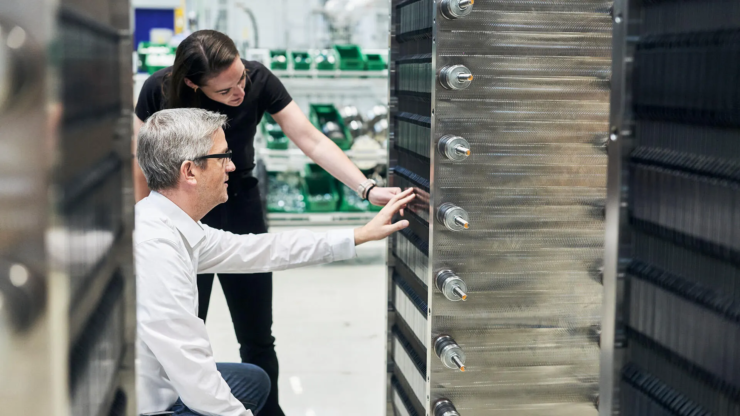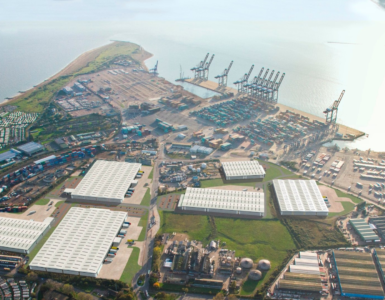Siemens – The future of hydrogen tech manufacturing.
It’s a factory for the future. One of the first gigawatt-scale electrolyzer factories in the world implementing modern robots and digitalization for a highly automated production, the new Siemens Energy Electrolyzer Manufacturing plant in Berlin, Germany, is fast-tracking sustainable manufacturing and the renewable hydrogen economy.
“What a week,” says 47-year-old engineer Axel von Levetzow, Head of Manufacturing at the Siemens Energy Gigawatt Electrolyzer Factory in Berlin, a joint venture between Siemens Energy and Air Liquide. It’s late September, and von Levetzow and colleagues have been busy installing new machinery and steadily increasing production. At the same time they’ve been presenting their plans for electrolyzer production to industrialists, entrepreneurs and politicians – including energy ministers from all over the world.
Interest is high because the factory, complete with robots, automation and digitalization, is a centerpiece for climate action and the world’s ambition to reach net zero emissions with a renewable hydrogen economy. Starting this November, the factory begins its gigawatt-scale production of electrolyzer stacks, starting with 1 gigawatt in the first year, moving to 2 gigawatts by 2024 and reaching 3 gigawatts as soon as 2025.
🔥 What about we co-host a webinar? Let's educate, captivate, and convert the hydrogen economy!
Hydrogen Central is the global go-to online magazine for the hydrogen economy, we can help you host impactful webinars that become a global reference on your topic and are an evergreen source of leads. Click here to request more details
von Levetzow, says:
Before, customers would say, ‘We need energy,’ and we built power plants for them.
“Now we can even deliver everything they need for a complete green hydrogen strategy.”
Robots with a gentle touch
Mara Mertens, Head of Technical Service at the plant, says:
Here at our production site in Berlin, we have a lot of experienced colleagues who know how to ramp up production and develop solutions with suppliers.
“This project is anything but plug and play.” She also points out that Siemens Energy has been closely cooperating with its long-term partners in the mechanical engineering industry: “It’s one thing for robots to handle spare parts in the car industry. But it’s much more difficult if they have to handle highly sensitive membranes with ultrathin layers.”
Mertens and von Levetzow studied mechanical engineering with a focus on renewables in the 2000s, when the field was driven by – as they put it – “idealists.” Then von Levetzow spent years further developing gas turbines, while Mertens traveled the world commissioning hydrogen-cooled generators at plants from Brazil to Egypt. Now they’re excited as never before about a project leading the way into the future of energy: “Each of us is ready to go the extra mile,”
Automating the production of PEM electrolyzers
And the extra mile is what it takes. The technology of proton exchange membrane (PEM) electrolysis is simple and some decades old: Water passes by a membrane and is split into hydrogen and oxygen. But the challenge is to scale the production to industrial volumes.
Up to now, at its former production location, Siemens Energy still used a lot of handwork. But the new factory is highly automated: Coating machines apply a thin platinum layer to the membrane on the one side and an iridium layer on the other side.
Mertens, says :
“The challenge is that the layer has to be very thin, because the raw material is expensive, but thick enough to make the membrane reliable,”
At the end of the line, containers are filled with the punching waste: All of that gets recycled, for ecological reasons, but also because of the value of the leftovers of platinum and iridium on the membrane.
Then the membrane gets laminated and pressed into rectangular forms, put into frames and finally assembled into the so-called stacks, about the height of a door. Then every stack gets transported to another hall to test the performance. At other manufacturing locations such as Mulheim, the stacks are assembled into the final product – an electrolyzer system consisting of four-by-six stack arrays and process parts that can be easily packed and transported to the construction site of the customer.
The fully automized camera quality control at the new factory is crucial: It can detect the slightest unevenness in the coating of the membrane – which could later lead to a less efficient functioning of the stacks. Most components are serialized, many components get optically scanned.
says Mertens.
“We’ve got all the data from the stacks up to the iridium charge that was used during production,”
“We get a digital twin of the production. That allows us to secure high quality of our products – and further develop the production every day.”
“Do you remember the times when solar energy was very expensive?” asks von Levetzow. “Then production was scaled up, and the prices of solar panels started dropping, making its production competitive. The same is about to happen with electrolysis. We’re seeing the moment when the train takes off.”
READ the latest news shaping the hydrogen market at Hydrogen Central
Siemens – The future of hydrogen tech manufacturing. source








